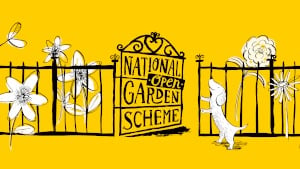About Hill Close Gardens
Any time from Feb to Oct is a great time to visit HCG as there is so much to see throughout the year in these 16 hedged town gardens, situated between the town centre and Warwick Racecourse. It is an opportunity to experience what was a very common horticultural feature in Victorian times, when many towns had similar detached gardens on their boundaries. These were owned by the tradesmen who lived in the town centres, often above their businesses. Sadly only four examples of these types of gardens remain to this day. The others have been subsumed by urban sprawl. That would have happened here but for the efforts of an energetic and knowledgeable residents association, which in 1994 obtained Grade II listing on four of the summer houses and later Grade II for the whole site. It prevented the houses being built on the site, which is now owned by Warwick District Council and managed by Hill Close Gardens Trust. A great restoration took place in 2005, transforming a totally overgrown and neglected site to that which we see today.
This garden is open to the public. Here they can enjoy the gardens and discover the social history of the townsfolk who owned them.
These gardens differed from allotments in that there was a rich diversity of fruit trees and soft fruit, flowers and exotic vegetables and lawns as well as summerhouses or wooden shelters. All this is well documented from the many bills of sale recorded when each freehold plot was sold. This diversity is maintained to this day so that each plot or garden has its own individuality.
Winter is an ideal time to see the structure of the Gardens which is based on the Ordinance Survey map of 1886. The site slopes westwards toward the Racecourse and is well drained. The maintenance of the views over the Racecourse and beyond is part of the conservation policy of the Trust and is a feature which adds to the ‘sense of place’ recognised by English Heritage. It is also a good time to see the small summerhouses which are a very special feature of the Gardens. (See photo). There are five of varying design, three of which are listed and two with basements still used to store fruit. A new addition is a small shelter based on the design of one which used to be in George Cadbury’s garden.
Each garden or plot is different, often reflecting the interests of those volunteers who are plot holders but always with a wide range of flowers, perennials and annuals, sometimes including a cutting border. The vegetables vary, often with heritage varieties such as the runner bean ‘Painted Lady’ being grown alongside the most recent introductions. There are also exotic vegetables – asparagus, artichokes, pak choi and others which vary from year to year.
There are four borders of special interest: the Victorian Border where only plants grown in Victorian times are to be found, the Rare Plant Border supported by Plant Heritage and used for the conservation of rare plants at risk from disappearing from commercial use, the Bulb Border and the Chrysanthemum Border.
Each season brings a special interest: late winter and early spring sees many snowdrops including some of the pre-1950s varieties and many more recent introductions. In total there are more than 140 different ones flowering from early December to April throughout the gardens (see photo). The highlight is the Snowdrop Weekend in February when an indoor display gives an opportunity to admire the different markings and leaf formation in the comfort of the tearoom. After the snowdrops and winter aconites there are lots of bulbs in the bulb border under the pear trees where there is the colour throughout the year from species tulips, Cyclamen, Tulbaghia and Crocosmia, finishing with Eucomis and Nerine in the early autumn.
In summer the herbaceous borders are filled with colour provided by Hemerocallis, Campanula and Phlox and many different perennials. Some of these are ‘at risk’ and grow in the Rare Plant Border. In late summer the colour changes with dahlias, crocosmias, Helenium and Aster ammellus, followed later by the jewel colours of Michaelmas daises including ‘Hill Close Blue’, an intense violet blue seedling found in the Gardens.
Finally in late autumn the Chrysanthemum Border, part of the Plant Heritage dispersed National Collection, demonstrates what excellent late flowering plants these are and delight with an amazing colour range until November (see photo).
The heritage apples are one of the major features of the Gardens, which are deemed to be an ancient orchard. There are over 70 different varieties ranging from the early ‘Beauty of Bath’ to ‘Bismark’, a very late cooker (see photo). The fruit blossom in the spring lasts for about six weeks. Apples are picked and stored for Apple Day in October when there is a great opportunity to taste and buy different varieties which would never be found in supermarkets.
To learn more about the horticulture of the gardens join the Head Gardener on his monthly Gardeners Walk, which in September focuses on the beautiful apples ripening on the tree before they are picked. It is a good time to gain information about the cultivation and pruning of these fruits.
There is also a Mulberry which will soon outgrow its space, a Medlar and a Quince. The flowers of the latter two are very pretty and would easily earn a place in any garden as a decorative flowering tree.
For those who are interested in garden artefacts there is a fascinating collection of working tools including a Warwickshire Tiller, hand thrown clay pots and early machinery, lawn mowers and rollers and a couple of market vegetable barrows. Not all are on display except for special events or tours.
In one of the pigsties, now a potting shed, are displays about the Chadband family and George Mills who cultivated that Plot.
A visit to the ever-expanding nursery is a must for all plant lovers seeking choice and rare plants which are seldom found in garden centres. Nearly all the plants, mainly hardy perennials are propagated from those already growing in the Gardens. In some cases only a small number of plants, especially the rare ones, have been propagated, so please check availability before making a special visit. Entry to the nursery is free.
The Victorian style glasshouse is a working glasshouse used for propagation, potting on seedlings, as well as displaying some of the rare and interesting succulents and epiphylliums donated to the Gardens. In the summer there is a conventional display of cold greenhouse plants such as pelargoniums and geraniums. The many different succulents and Echeveria (see photo) are much admired. Another section has begonias and Coleus grown for their leaf shape and colour. The cactus are sited in this area which in the winter is kept at just above freezing point. The glasshouse is used for the big display of apples, pears and other fruit on Apple Day. In spring snowdrops and spring bulbs can be seen in the warmth and protection of the glasshouse.
The willow tunnel in the children’s garden delights small children who spend much time there whilst parents are enjoying coffee and cake in the Tearoom. It is also used as a hands-on garden for very young children during the regular drop-in sessions held during the week.
Visitors are very welcome, see our website for opening times.
Website:
https://www.hillclosegardens.com
.jpg)
.jpg)
.jpg)
.jpg)
.jpg)
.jpg)
.jpg)
.jpg)
.jpg)
.jpg)
.jpg)
.jpg)



.jpg)
.jpg)
.jpg)
.jpg)